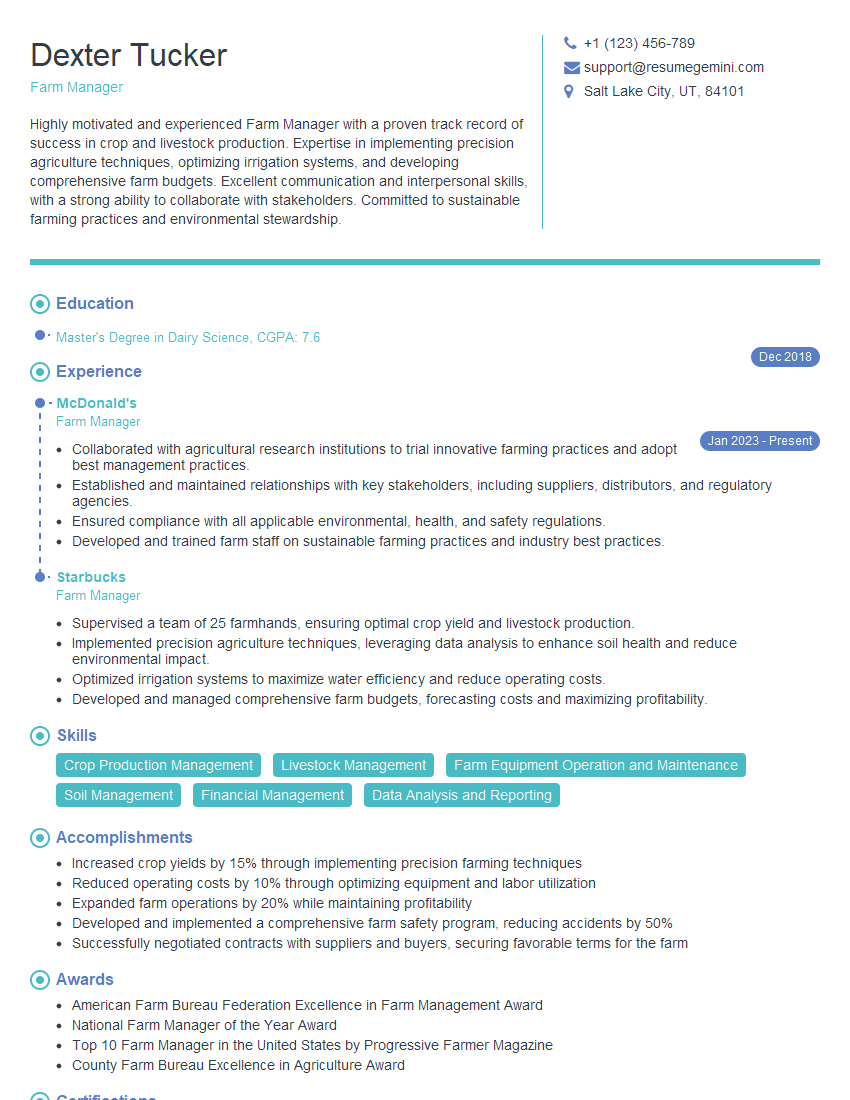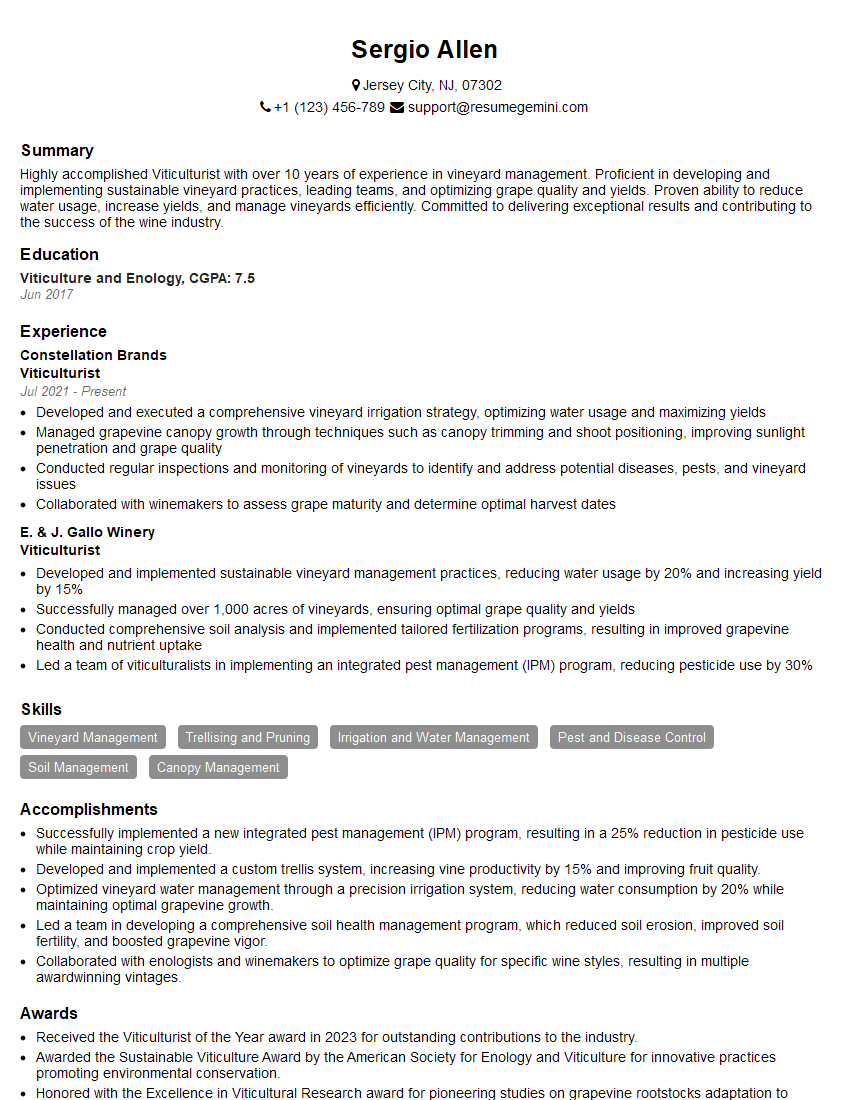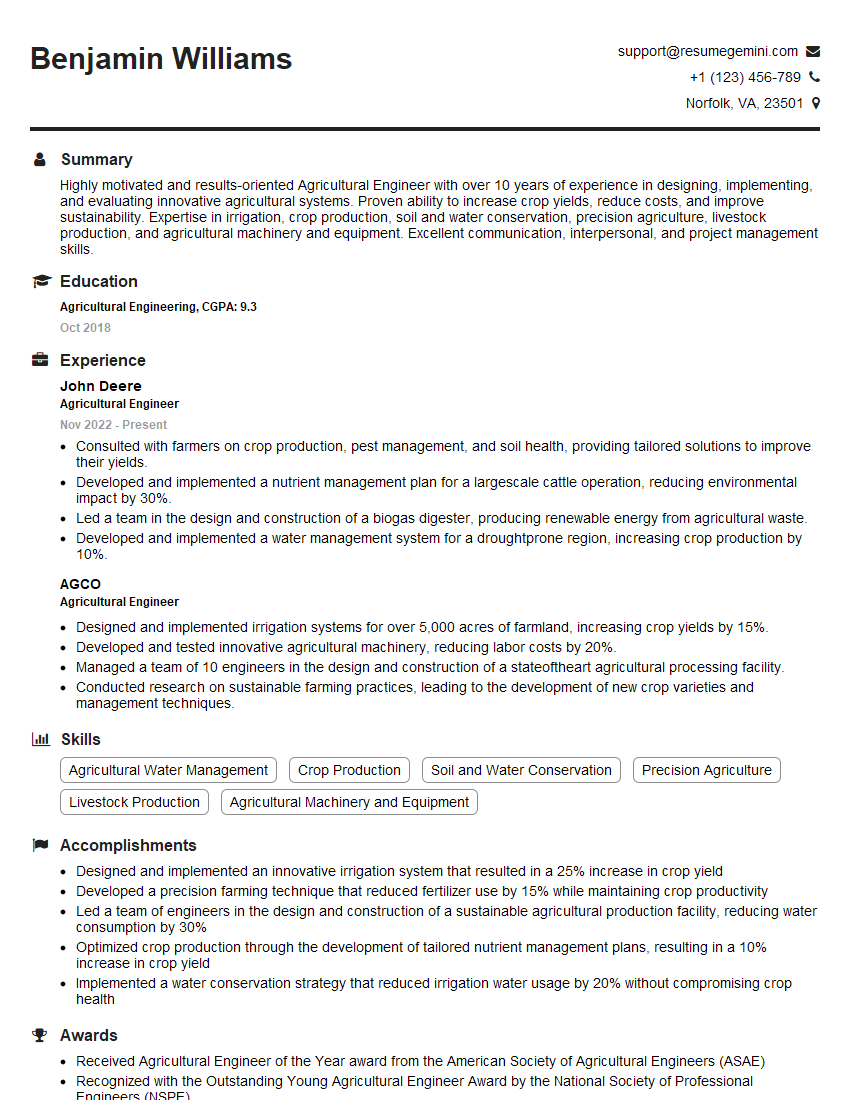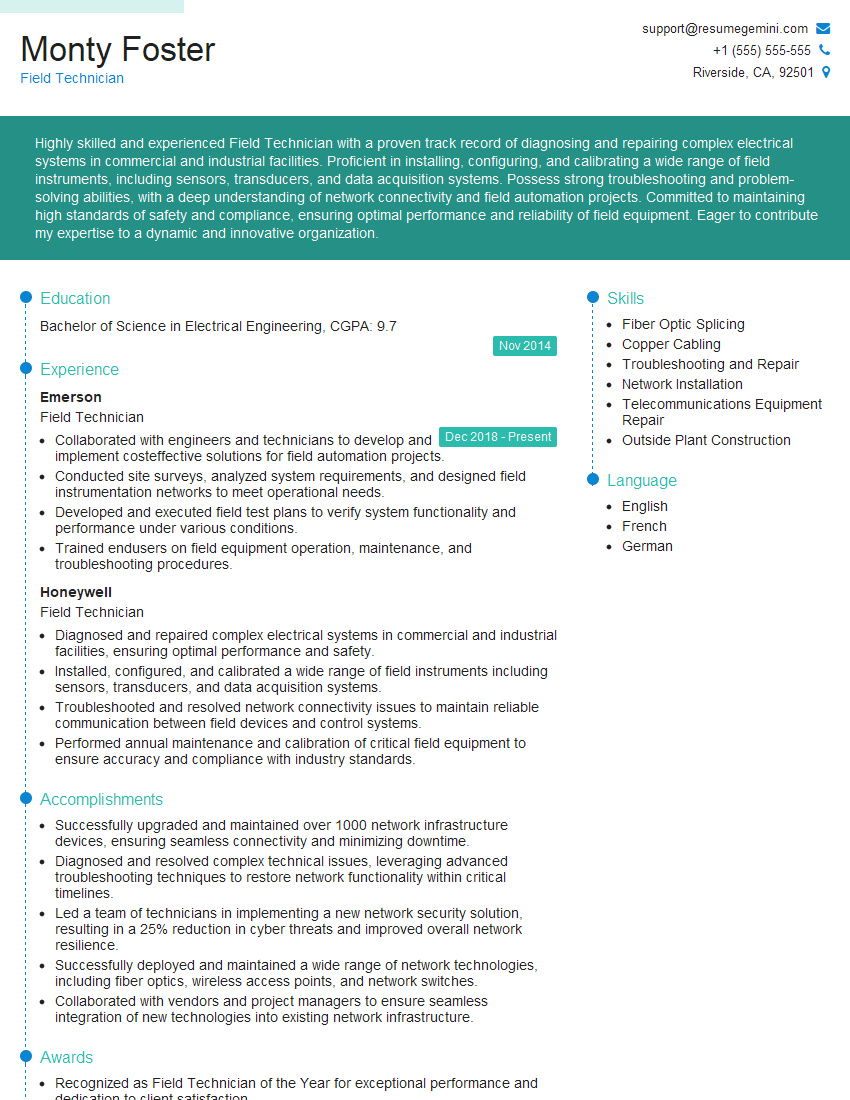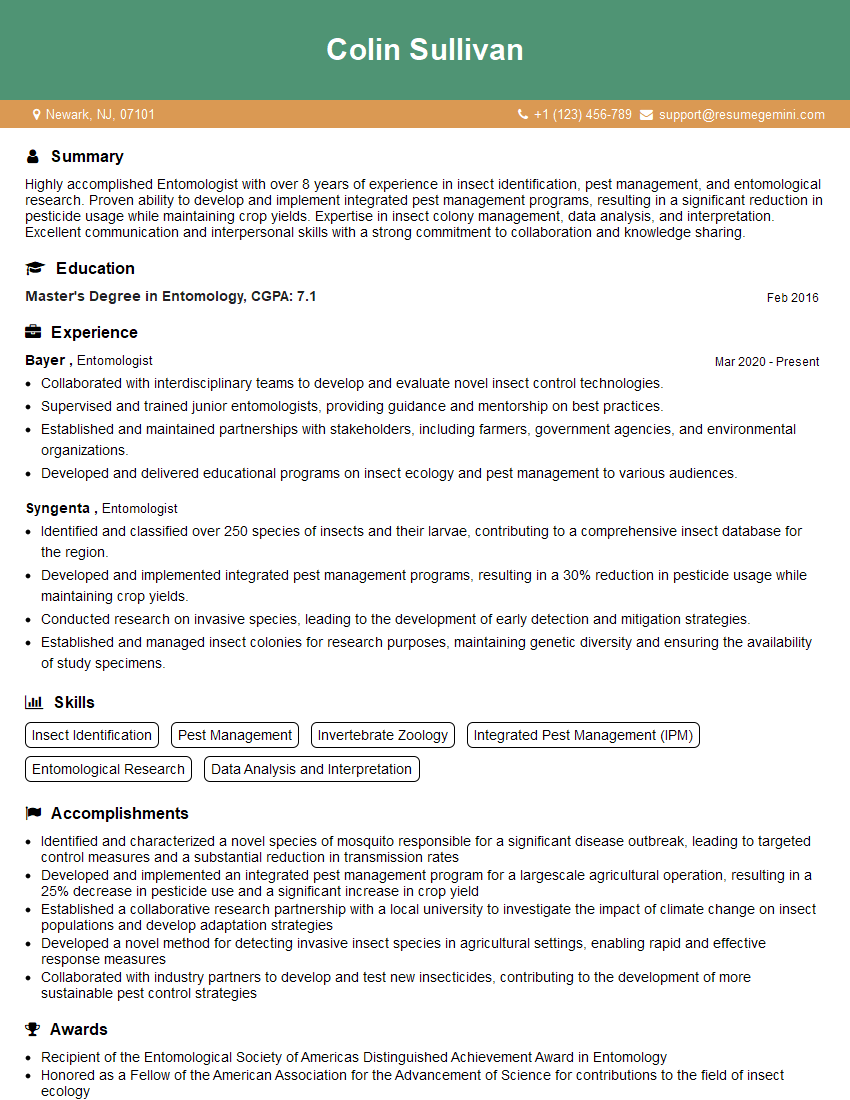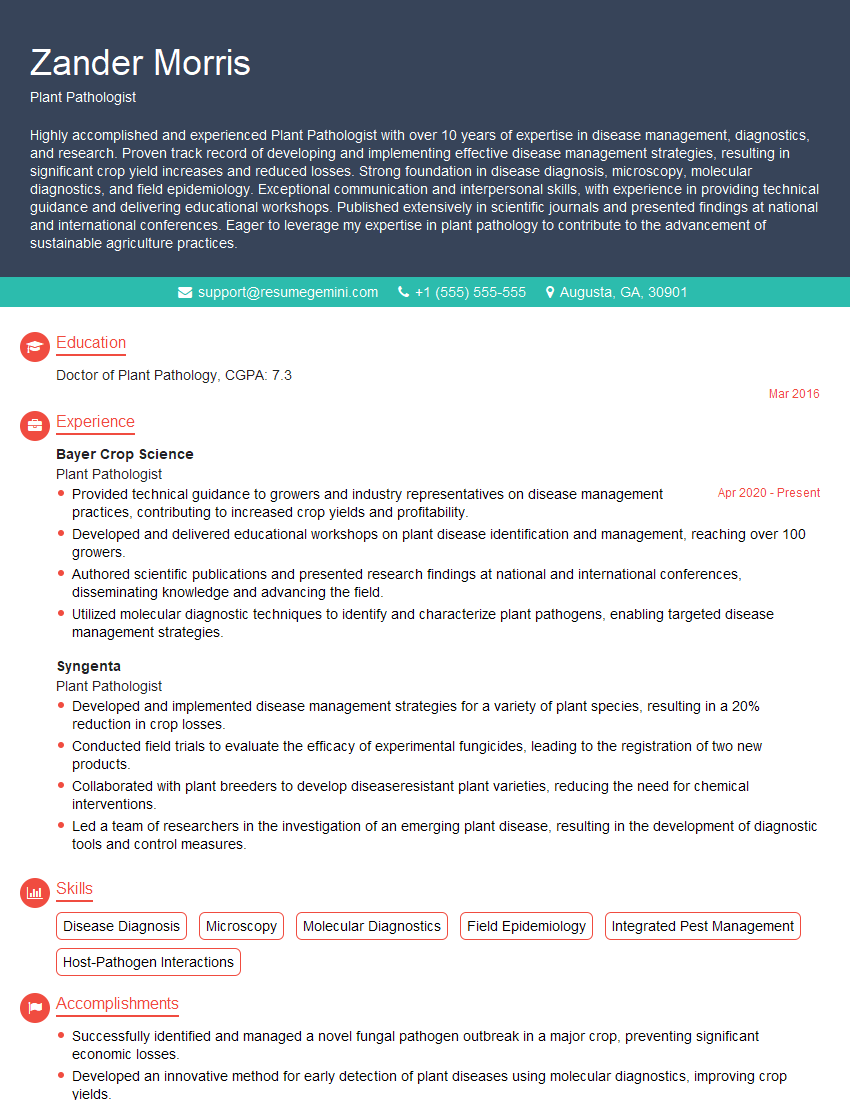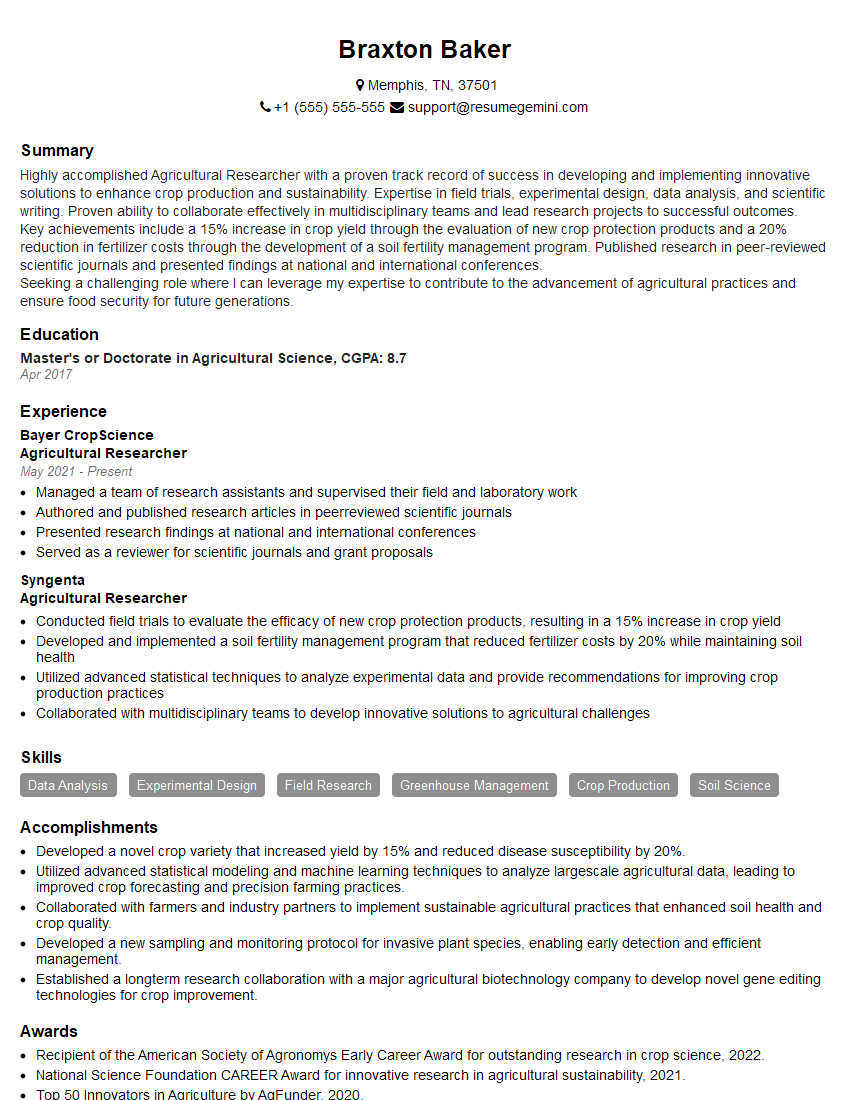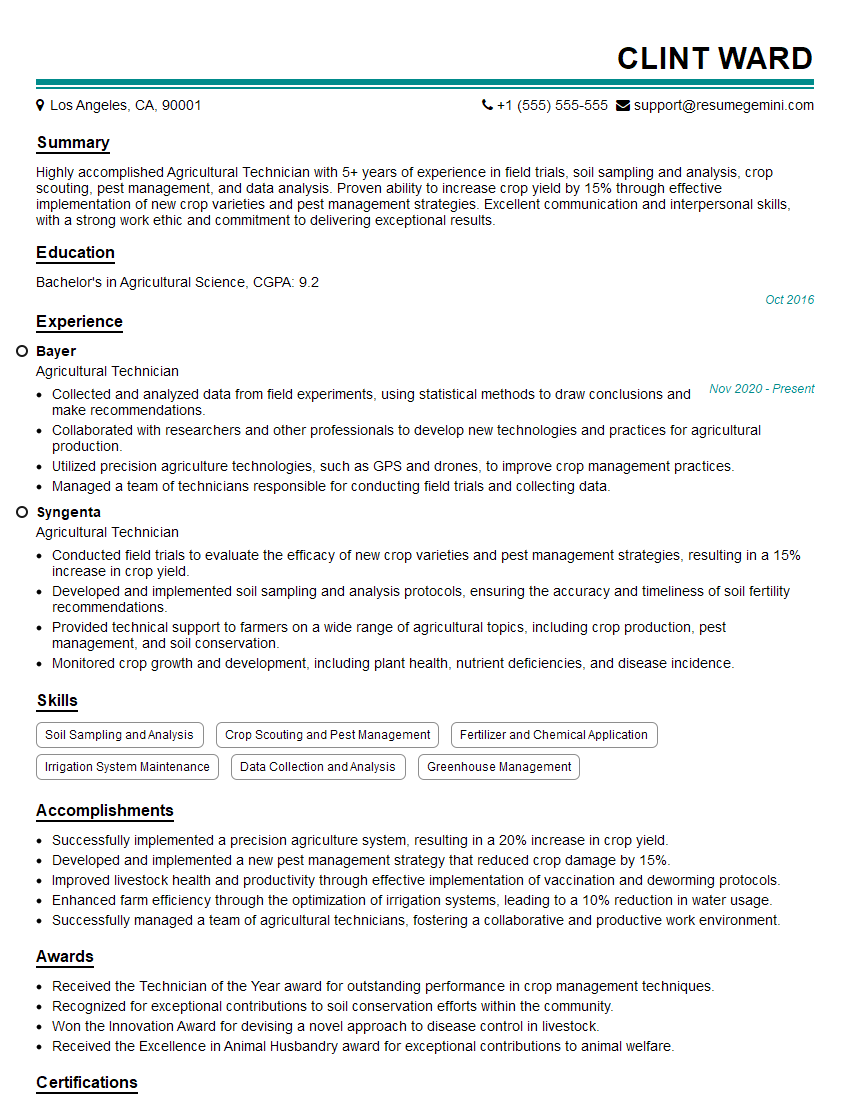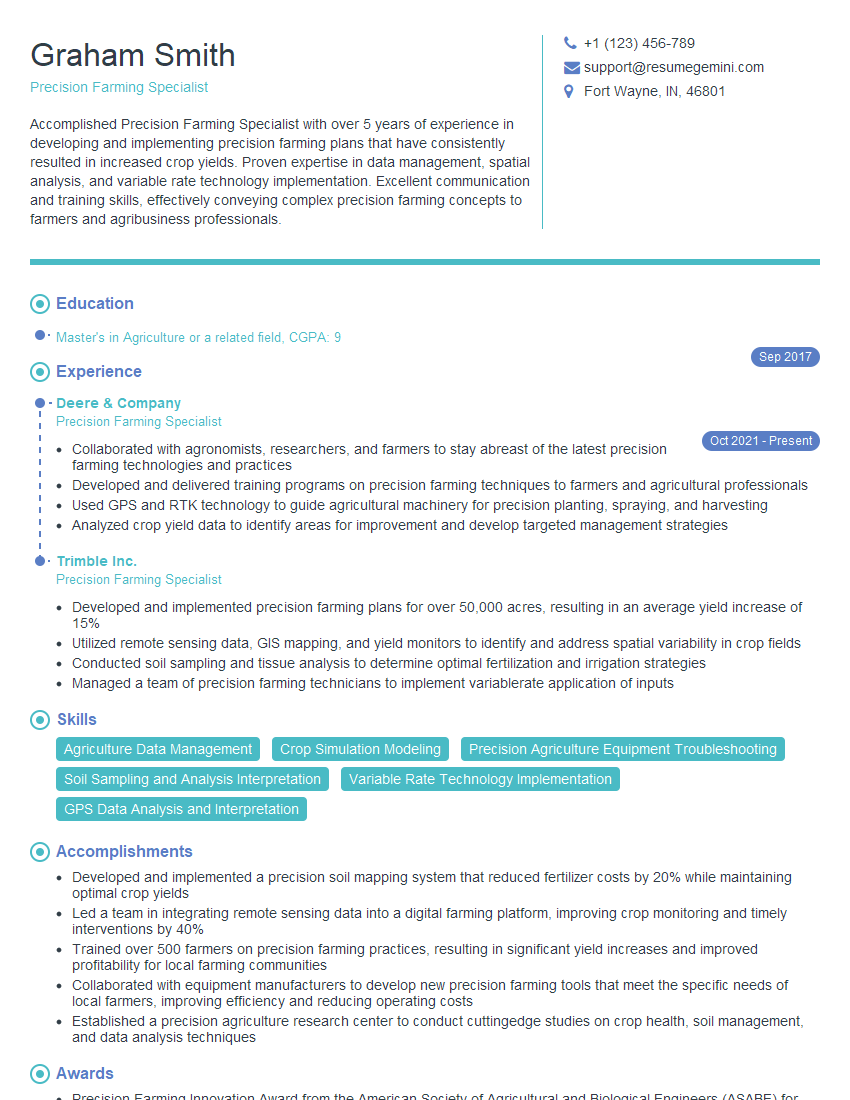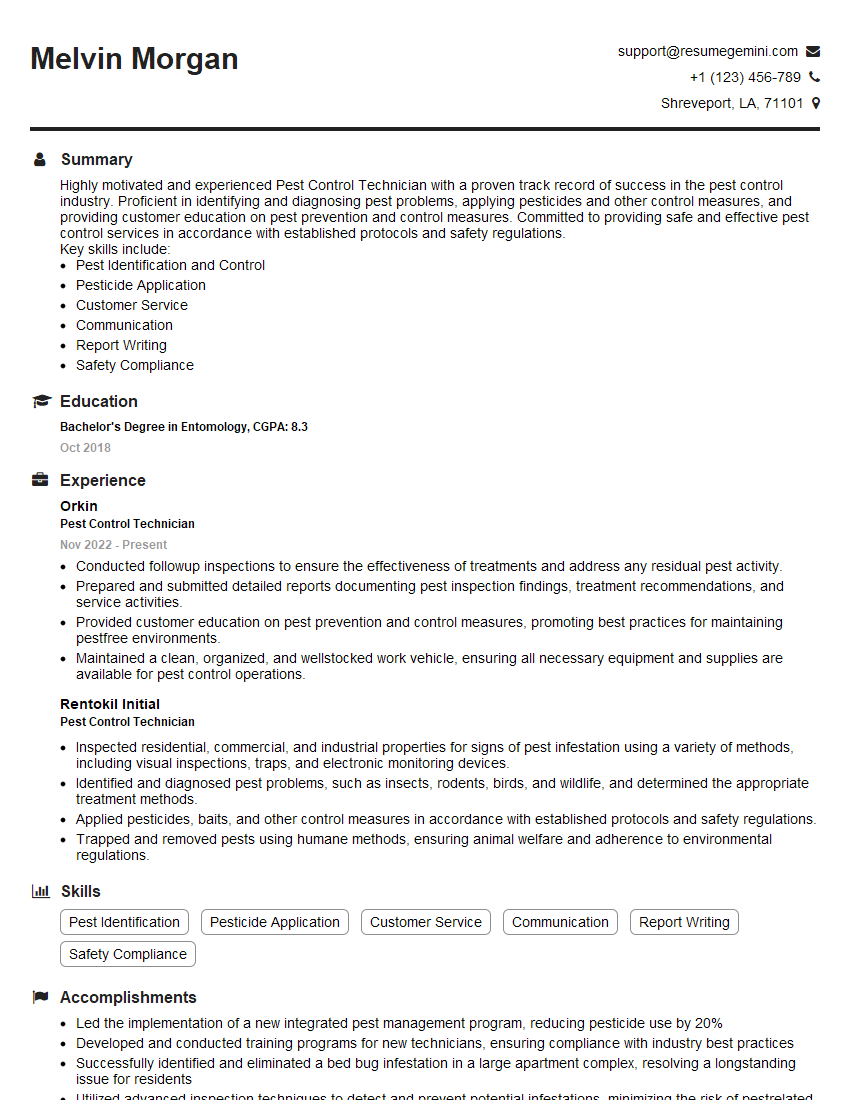Interviews are more than just a Q&A session—they’re a chance to prove your worth. This blog dives into essential Crop Monitoring and Pest Control interview questions and expert tips to help you align your answers with what hiring managers are looking for. Start preparing to shine!
Questions Asked in Crop Monitoring and Pest Control Interview
Q 1. Explain the principles of Integrated Pest Management (IPM).
Integrated Pest Management (IPM) is a sustainable approach to pest control that aims to minimize pesticide use while maximizing crop protection. It’s not about eliminating pests entirely – that’s often impossible and can be environmentally damaging – but about keeping pest populations below the economic injury level. Think of it as a balanced ecosystem approach.
- Monitoring: Regularly checking crops for pest and disease presence and severity is crucial. This informs all subsequent decisions.
- Prevention: Proactive measures like crop rotation, using pest-resistant varieties, and proper sanitation can significantly reduce pest pressure before it becomes a major problem. Imagine it like preventing a fire before it starts.
- Biological Control: Introducing natural enemies of pests, such as beneficial insects or microorganisms, to control pest populations. This is like having a natural security system in your field.
- Cultural Control: Employing farming practices that discourage pest development. This could include adjusting planting dates, altering irrigation techniques, or using proper fertilization. It’s about creating a less hospitable environment for pests.
- Chemical Control: Using pesticides as a last resort, only when other methods are insufficient and the economic threshold has been exceeded. This is the ‘heavy artillery,’ used strategically and sparingly.
For example, in managing aphids on a lettuce crop, an IPM approach might start with monitoring aphid populations. If numbers are low, no action is needed. If populations increase, introducing ladybugs (a natural predator) could be considered. Only if aphid numbers reach a damaging level would targeted pesticide application be necessary. This minimizes pesticide use and protects beneficial insects.
Q 2. Describe different methods for crop monitoring (visual, remote sensing, etc.).
Crop monitoring is vital for early detection of pest and disease problems. Several methods exist:
- Visual Inspection: This is the most basic method, involving walking through fields and carefully examining plants for signs of pests or diseases. It’s effective for smaller areas but can be time-consuming and subjective.
- Remote Sensing: This uses technology like drones or satellites equipped with sensors to monitor crops over large areas. Multispectral or hyperspectral imagery can detect subtle changes in plant health that indicate stress from pests or diseases, often before visible symptoms appear. Think of it like getting a detailed health report of your entire field from above.
- Traps: Sticky traps or pheromone traps attract and capture specific pests, providing information about pest presence and population density. They’re especially useful for monitoring flying insects.
- Scouting Tools: Specialized equipment like sweep nets or beat sheets aid in collecting samples for further analysis.
For instance, a grower might use visual inspection combined with a drone equipped with a multispectral camera to monitor a large cornfield. The drone identifies areas of potential stress, and visual inspection then confirms the presence of corn borers.
Q 3. What are the key factors to consider when selecting a pesticide?
Selecting the right pesticide is crucial for effective pest control and minimizing environmental impact. Key factors to consider include:
- Target Pest: The pesticide must be effective against the specific pest identified. Using the wrong pesticide is like using a hammer to tighten a screw – ineffective and potentially wasteful.
- Toxicity: Consider the pesticide’s toxicity to humans, beneficial insects, and other non-target organisms. Choosing a less toxic option is crucial for environmental protection and worker safety.
- Persistence: How long the pesticide remains active in the environment affects its impact on non-target organisms and potential residue concerns in the harvested crop.
- Mode of Action: Understanding how the pesticide works helps to avoid developing pest resistance. Varying modes of action across applications slows down the development of resistance. Think of it as using different tools to combat a persistent foe.
- Cost-effectiveness: Balancing cost with efficacy and environmental impact is essential.
- Application Method: Compatibility with the chosen application equipment is necessary.
For example, when choosing a pesticide for controlling Colorado potato beetles, one would need to consider its toxicity to bees (important for pollination), its persistence in the environment, and its effectiveness against the specific beetle population. A low-toxicity, targeted pesticide with a different mode of action than previously used might be the most effective and responsible choice.
Q 4. How do you identify common crop pests and diseases?
Identifying crop pests and diseases requires a combination of observation, knowledge, and sometimes laboratory testing.
- Visual Symptoms: Carefully examine plants for visible signs of damage, such as leaf discoloration, wilting, holes in leaves, or presence of insects or their droppings. This is often the first step, and a detailed visual examination can tell you a lot.
- Field Guides and Resources: Utilize field guides, online resources, or expert consultations to compare observed symptoms with known pest and disease characteristics. This is like having a handbook for plant diseases and insect problems.
- Sampling and Laboratory Analysis: In cases of uncertainty, collecting samples for laboratory diagnosis can provide accurate identification of the problem. This would help ensure a targeted response and prevent misdiagnosis, which can be costly in terms of time and resources.
For instance, if a farmer observes yellowing leaves and stunted growth on their tomato plants, they can consult a field guide for tomato diseases and pests. The symptoms might point toward a fungal infection like early blight, requiring different management strategies compared to an insect infestation like aphids. If the problem is unclear, sending a sample to a diagnostic lab would lead to a definitive identification.
Q 5. Explain the concept of economic thresholds in pest management.
The economic threshold in pest management represents the pest population density at which control measures become economically justified. In simpler terms, it’s the point where the cost of controlling the pest becomes less than the potential losses caused by the pest damage.
It’s a critical concept because it avoids unnecessary pesticide applications and saves money. Applying pesticides when the pest population is below the economic threshold is wasteful and may have negative environmental consequences. However, waiting until damage is severe can result in significant yield loss.
Calculating the economic threshold considers the cost of control measures (pesticide, labor, etc.), the value of the crop, and the relationship between pest density and yield loss. Different crops and pests have different economic thresholds. It’s a dynamic value that changes depending on the crop’s market value and the pest’s impact.
For example, the economic threshold for aphids on wheat might be lower than for aphids on lettuce because the economic value of a lettuce crop is typically higher, making earlier intervention worthwhile.
Q 6. Describe your experience with different types of pesticide application equipment.
My experience includes working with a variety of pesticide application equipment, each with its strengths and weaknesses:
- Hand-held Sprayers: Ideal for small areas or spot treatments, offering precision but requiring considerable labor. This is great for small gardens or targeted applications.
- Boom Sprayers: Mounted on tractors or other vehicles, these are efficient for covering large areas but require careful calibration to ensure even distribution. This method is used for large fields.
- Airblast Sprayers: Using high-pressure air to atomize and distribute pesticide, they’re effective for covering tall crops like trees but can have drift issues. They allow for high coverage, particularly in orchards.
- Drone Sprayers: A relatively new technology offering high precision and efficiency, especially in challenging terrains. They can make application very efficient and targeted.
Choosing the right equipment depends on factors like field size, crop type, topography, and the pesticide formulation. Each device requires appropriate training and adherence to safety protocols for safe and effective use.
Q 7. How do you interpret pest scouting data?
Interpreting pest scouting data is a crucial step in IPM. It’s not just about the numbers but also understanding the context.
- Pest Identification: Accurate identification of the pest is paramount. Misidentification can lead to ineffective control measures.
- Population Density: The number of pests per plant or per unit area helps determine if the economic threshold has been reached.
- Distribution Pattern: Is the pest infestation localized or widespread? This dictates the type and scale of control measures.
- Developmental Stage: The life stage of the pest (egg, larva, adult) influences the effectiveness of different control methods.
- Crop Growth Stage: The vulnerability of the crop to pest damage can vary depending on its growth stage.
For example, finding a high density of early-stage corn borers localized in one section of a field suggests spot treatment with a targeted insecticide might suffice. However, a widespread infestation of adult corn borers might require a broader approach, potentially including cultural controls and/or a different insecticide.
Effective data interpretation requires meticulous record-keeping, combined with an understanding of pest biology and crop vulnerability. Data visualization techniques such as maps or graphs can help illustrate patterns and guide decision-making.
Q 8. What are the environmental impacts of pesticide use?
Pesticide use, while crucial for crop protection, carries significant environmental consequences. The impacts can be broadly categorized into effects on non-target organisms, soil and water contamination, and contribution to air pollution.
- Non-target organisms: Pesticides can harm beneficial insects like bees, crucial for pollination, as well as birds, fish, and other wildlife. For example, broad-spectrum insecticides can decimate beneficial insect populations, disrupting the delicate balance of the ecosystem.
- Soil and water contamination: Pesticides can leach into groundwater and surface water, contaminating drinking water sources and harming aquatic life. Runoff from fields following pesticide application can lead to significant water pollution events, impacting downstream ecosystems.
- Air pollution: Pesticide application, particularly aerial spraying, can release pesticides into the air, posing respiratory hazards to humans and animals. These airborne particles can travel long distances, affecting areas far from the application site.
Minimizing these impacts requires integrated pest management (IPM) strategies, which emphasize preventative measures, biological control, and judicious use of pesticides only when absolutely necessary and with precise application techniques.
Q 9. How do you ensure the safety of pesticide application?
Ensuring the safety of pesticide application involves a multifaceted approach incorporating pre-application planning, safe handling procedures, and post-application monitoring. This begins with a thorough understanding of the pesticide label, which provides crucial information on safe handling, application rates, and personal protective equipment (PPE) required.
- Pre-application planning: This includes careful selection of the pesticide based on its efficacy and environmental impact, accurate assessment of weather conditions (avoiding spraying during windy conditions or when rain is imminent), and identifying sensitive areas near application sites that may need extra protection.
- Safe handling procedures: Always use the recommended PPE, including gloves, masks, and protective clothing. Proper mixing and application techniques are vital to prevent spills and exposure. Equipment should be cleaned thoroughly after use. Storing pesticides in a secure, labeled location away from children and animals is critical.
- Post-application monitoring: Checking for drift or unexpected impacts on nearby environments is important. This could include monitoring water sources for contamination or observing non-target organisms for any adverse effects. Proper disposal of empty containers is also essential.
Training and certification programs for pesticide applicators are key to ensuring safe and responsible use. Regular inspections and adherence to safety protocols are crucial to minimizing risks.
Q 10. What are the benefits and limitations of using drones for crop monitoring?
Drones are transforming crop monitoring by offering high-resolution imagery and efficient data acquisition over large areas. This enables early detection of problems and more targeted interventions, leading to improved yields and reduced resource use.
- Benefits: Drones provide detailed images for disease and pest detection, enabling early intervention and precise application of pesticides. They can survey large fields rapidly, reducing labor costs and time. They also allow for the creation of high-resolution maps of crop health, helping optimize irrigation and fertilization strategies.
- Limitations: Weather conditions like strong winds or rain can significantly hamper drone operation. High initial investment costs can be a barrier for smaller farms. Data analysis requires specialized software and skills. Privacy concerns related to aerial imagery might exist, necessitating adherence to local regulations. Battery life and flight range can also limit the operational area during a single flight.
The success of drone-based crop monitoring relies on a combination of appropriate technology, robust data analysis techniques, and well-trained personnel. Integrating drone data with other sources of information, like weather data or soil sensors, further enhances the effectiveness of the technology.
Q 11. Describe your experience with data analysis software for agricultural data.
My experience with data analysis software for agricultural data is extensive. I’m proficient in various platforms and programming languages, including R, Python (with libraries like Pandas and Scikit-learn), and GIS software like ArcGIS. I’ve worked with large datasets encompassing diverse parameters like yield data, weather information, satellite imagery, and sensor readings.
For example, in a recent project, we used R to analyze multispectral imagery from drones to identify areas with nutrient deficiencies in a corn field. The processed data allowed us to create precise maps guiding targeted fertilizer application, optimizing nutrient use and minimizing environmental impact. We also used Python to build predictive models to forecast pest outbreaks based on historical data and environmental factors.
My expertise extends to data visualization and reporting. I create clear and informative dashboards and reports to communicate findings effectively to stakeholders. Proficiency in statistical analysis methods, including regression analysis and machine learning techniques, enables data-driven decision-making in optimizing agricultural practices.
Q 12. How do you manage pesticide resistance?
Pesticide resistance is a major challenge in crop protection. It occurs when pests evolve mechanisms to survive pesticide exposure, rendering the chemicals ineffective. Managing this requires a multi-pronged approach emphasizing preventative measures and sustainable practices.
- Integrated Pest Management (IPM): IPM is central to resistance management. It emphasizes monitoring pest populations to determine the need for intervention, employing non-chemical methods such as crop rotation, biological control (using natural predators or pathogens), and cultural practices that enhance the plant’s natural defenses.
- Pesticide rotation: Using different pesticide classes with different modes of action prevents the selection of resistant individuals. Avoid using the same pesticide repeatedly on the same crop.
- Refugia: Leaving untreated areas within a field allows for the survival of susceptible pest populations, thus delaying the development of widespread resistance.
- Resistance monitoring: Regularly assessing pest populations for resistance levels is vital to detect early warning signs and adjust pest management strategies accordingly.
Understanding the pest’s biology and resistance mechanisms is crucial. Utilizing molecular techniques can help identify resistance genes, facilitating the development of more effective management strategies. Collaboration with researchers and sharing data on resistance patterns are also crucial.
Q 13. Explain the different types of traps used in pest monitoring.
Various traps are used in pest monitoring, each designed to attract specific pests based on their behavior and biology. The choice of trap depends on the target pest and the information needed.
- Pheromone traps: These traps utilize synthetic sex pheromones to lure male insects. They are useful for monitoring pest populations, detecting their presence, and determining the timing of pest outbreaks. The number of trapped insects provides an estimate of the pest population density.
- Sticky traps: These traps use a sticky surface to capture insects. They are often used for monitoring flying insects such as aphids or whiteflies. They are relatively inexpensive and easy to deploy, offering a quick assessment of pest pressure.
- Pitfall traps: These are small containers buried in the ground used to capture crawling insects like beetles or ants. They are particularly useful in monitoring ground-dwelling pests.
- Light traps: These traps utilize light to attract nocturnal insects. They are commonly used in monitoring moths and other night-flying pests. The effectiveness can be affected by moonlight and other light sources.
Trap data should be analyzed regularly to inform timely and targeted interventions. The type of trap used, its location, and the frequency of monitoring impact the accuracy of pest population estimations.
Q 14. What are the common pests affecting [specific crop, e.g., corn] in your region?
Assuming our region is a typical corn-growing area in the Midwest United States, some of the most common pests affecting corn include:
- Corn rootworm (Diabrotica virgifera virgifera): Larvae feed on corn roots, reducing plant vigor and yield. Adults can also damage foliage.
- Western corn rootworm (Diabrotica virgifera): Similar to the corn rootworm, damaging roots and reducing plant health.
- European corn borer (Ostrinia nubilalis): Larvae bore into corn stalks, damaging plants and reducing yield. This pest is particularly problematic in areas with high corn density and minimal crop rotation.
- Aphids (various species): These sap-sucking insects can transmit plant viruses and reduce plant growth. They are often more problematic in periods of stress or drought.
- Fall armyworm (Spodoptera frugiperda): The larvae of these moths feed on leaves and stems, particularly during late summer. Outbreaks can cause significant yield losses.
Effective pest management for corn relies on scouting fields regularly, identifying early signs of infestation, and implementing appropriate control measures, prioritizing IPM strategies to minimize environmental impact. The specific pest challenges will vary based on local environmental conditions and farming practices.
Q 15. How do you assess the effectiveness of a pest control strategy?
Assessing the effectiveness of a pest control strategy involves a multi-faceted approach that goes beyond simply observing whether pests are present. We need to quantify the impact of the strategy on both pest populations and crop yield.
- Population Monitoring: Before, during, and after implementing the strategy, we meticulously monitor pest populations using various techniques like trap counts, visual inspections, and potentially more advanced methods such as pheromone trapping. This allows us to track population densities and determine if the strategy is effectively reducing pest numbers. For example, comparing trap counts of a specific pest before and after applying a particular insecticide allows for a quantitative assessment of its efficacy.
- Crop Damage Assessment: The ultimate goal is to protect the crop. We assess the level of damage inflicted by pests on the plants. This can involve evaluating factors such as the percentage of damaged leaves, fruits, or stems, and the overall impact on crop yield and quality. Visual scoring scales can be used to standardize this assessment.
- Yield Analysis: A reduction in pest damage ideally translates into increased yield. Comparing the yield of treated areas with untreated control areas (if ethically and practically feasible) is crucial in evaluating the effectiveness of the strategy. Statistical analysis can then determine if the differences are significant.
- Economic Analysis: The cost-effectiveness of the strategy needs to be considered. We weigh the cost of implementing the strategy against the increase in yield and the value of the reduced crop loss. This ensures that the control strategy is economically viable.
It’s important to remember that a single metric is rarely sufficient. A comprehensive assessment requires integrating multiple data points to obtain a holistic picture of the strategy’s success.
Career Expert Tips:
- Ace those interviews! Prepare effectively by reviewing the Top 50 Most Common Interview Questions on ResumeGemini.
- Navigate your job search with confidence! Explore a wide range of Career Tips on ResumeGemini. Learn about common challenges and recommendations to overcome them.
- Craft the perfect resume! Master the Art of Resume Writing with ResumeGemini’s guide. Showcase your unique qualifications and achievements effectively.
- Don’t miss out on holiday savings! Build your dream resume with ResumeGemini’s ATS optimized templates.
Q 16. Describe your experience with using GIS in agriculture.
Geographic Information Systems (GIS) are invaluable tools in precision agriculture, allowing for spatially explicit management of pest control. In my experience, I’ve used GIS to:
- Map pest infestations: By overlaying pest occurrence data with geographical information, such as field boundaries, soil types, and environmental factors, we can identify hotspots of pest activity and tailor our control efforts accordingly. This targeted approach reduces the need for broad-spectrum treatments, thus minimizing environmental impact and costs.
- Optimize pesticide application: GIS can create variable rate application maps that direct machinery to apply pesticides only to areas where they are needed, further optimizing resource use and mitigating environmental risks. For example, if a pest infestation is concentrated in a specific part of a field, the GIS-generated map would allow the sprayer to apply more pesticide to that area and less or none to areas without a problem.
- Monitor crop health: Integration of remote sensing data (e.g., multispectral imagery from drones or satellites) with GIS allows for the assessment of crop health indicators like Normalized Difference Vegetation Index (NDVI). This helps to identify stressed plants, which are often more susceptible to pest attack, allowing for proactive pest control measures.
- Plan scouting routes: GIS can generate optimal routes for field scouts, minimizing travel time and ensuring efficient coverage of the entire area, leading to early detection of pest issues.
In one project, I used GIS to model the spread of an invasive insect based on climate data and terrain features. This predictive model helped to inform proactive control measures and prevent the insect from reaching vulnerable areas.
Q 17. Explain the role of beneficial insects in pest control.
Beneficial insects play a crucial role in Integrated Pest Management (IPM) by naturally suppressing pest populations. They form a critical component of a healthy ecosystem, helping to maintain a balance.
- Predators: Many insects, like ladybugs and lacewings, prey on common crop pests such as aphids and mites. They actively hunt and consume these pests, reducing their numbers and preventing significant damage.
- Parasitoids: These insects lay their eggs on or inside pest insects. The larvae then feed on the pest, eventually killing it. This offers a highly specific method of control.
- Pollinators: While not directly involved in pest control, pollinators like bees are essential for crop production. Healthy pollinator populations ensure good yields, reducing dependence on intensive pest control that could otherwise harm beneficial insects.
Encouraging beneficial insects involves creating a favorable habitat. This could include planting flowering plants that provide nectar and pollen as food sources, providing shelter such as hedgerows or artificial shelters, and avoiding broad-spectrum pesticides that could kill both pests and beneficial insects. For example, leaving patches of unmowed vegetation at the edge of a field can provide habitat for beneficial insect populations.
Q 18. How do you develop a pest control plan for a specific crop?
Developing a pest control plan for a specific crop requires a systematic and integrated approach.
- Crop Identification and Vulnerability: Thoroughly understand the crop’s susceptibility to various pests, its growth stages, and its specific environmental requirements.
- Pest Identification and Monitoring: Identify the key pests that threaten the specific crop in the region. Regular monitoring using scouting techniques, traps, and visual inspections helps track pest presence and population dynamics.
- Economic Thresholds: Determine the economic threshold, which is the pest population level at which control measures become economically justified. This is based on the cost of control versus potential crop loss.
- Control Strategies: Based on the economic threshold and pest severity, implement appropriate control measures. This might involve a combination of cultural practices, biological control (using beneficial insects), and chemical control (using pesticides as a last resort).
- Integrated Pest Management (IPM): IPM emphasizes a balanced and integrated approach prioritizing preventive measures and minimizing chemical pesticide use. It involves regular monitoring, implementing cultural controls, employing biological control agents, and using pesticides only when absolutely necessary.
- Record Keeping: Maintain detailed records of pest populations, control measures implemented, and their effectiveness. This data informs future control strategies and helps refine the IPM plan.
For example, in a corn field prone to corn borer infestation, the plan could involve rotating crops, using resistant varieties, employing pheromone traps for monitoring, and deploying parasitoid wasps for biological control. Chemical control would only be used as a last resort if the other measures prove insufficient to keep the infestation below the economic threshold.
Q 19. What are some non-chemical methods of pest control?
Non-chemical methods of pest control are crucial elements of an effective IPM strategy, offering environmentally friendly and sustainable alternatives to pesticides.
- Cultural Controls: These practices aim to make the crop less susceptible to pests. Examples include crop rotation to disrupt pest life cycles, using resistant crop varieties, adjusting planting dates to avoid peak pest activity, proper sanitation to remove pest habitats, and optimizing irrigation and fertilization to enhance plant vigor.
- Biological Controls: This involves using natural enemies of the pests, such as predators, parasitoids, and pathogens. Introducing these beneficial organisms into the environment can effectively suppress pest populations. For example, releasing ladybugs to control aphids.
- Mechanical Controls: These methods physically remove or kill pests. Examples include handpicking pests, using traps (sticky traps, pheromone traps, etc.), and using physical barriers like nets or row covers.
- Physical Controls: Utilizing techniques such as adjusting temperature or humidity in storage facilities, and using UV light or sound waves (in specific situations) to deter or kill pests.
For example, a farmer might use row covers to protect seedlings from insect damage, and later in the season introduce beneficial nematodes into the soil to control root-feeding pests.
Q 20. Describe your experience with soil testing and its relevance to pest management.
Soil testing is fundamental to effective pest management because soil health directly influences plant health and susceptibility to pests.
- Nutrient Levels: Nutrient deficiencies make plants more vulnerable to pests. Soil tests reveal nutrient levels, enabling us to adjust fertilization practices, ensuring plants are strong and less susceptible. Plants lacking essential nutrients are more likely to be attacked by pests.
- Soil pH: Soil pH impacts nutrient availability and also affects the activity of beneficial soil microorganisms. Knowing the pH allows us to amend the soil to optimize conditions for both plant health and beneficial organisms.
- Soil Structure: Poor soil structure can increase the vulnerability of plants to pests. Soil testing can identify compaction or other issues that compromise root development and plant vigor. Healthy soil structure improves plant health and resilience to pests.
- Pathogen and Pest Presence: Some soil tests can detect the presence of soilborne pathogens and pests, enabling us to take preventative measures or implement appropriate control strategies.
In a recent project, soil testing revealed a significant potassium deficiency in a potato field. This explained the increased incidence of potato leafhoppers, which are more attracted to stressed plants. Addressing the potassium deficiency through appropriate fertilization helped to mitigate the pest problem.
Q 21. How do you handle unexpected pest outbreaks?
Handling unexpected pest outbreaks demands a rapid and decisive response.
- Rapid Assessment: Immediately identify the pest and assess the extent of the infestation. Accurate identification is critical for choosing the appropriate control methods. Consider using rapid diagnostic techniques if available.
- Emergency Control Measures: Implement appropriate control measures based on the pest and the urgency of the situation. This may involve using pesticides as a last resort, but only after considering the environmental consequences and using the least toxic option.
- Monitor and Evaluate: Continuously monitor the effectiveness of the emergency measures. Regularly check pest populations to assess whether the implemented controls are working and make any necessary adjustments.
- Long-Term Prevention: Analyze the outbreak to determine the contributing factors (weather, cultural practices, etc.). Implement long-term preventative strategies to reduce the risk of future outbreaks. This may involve refining the existing IPM plan.
- Consult and Collaborate: Seek expert advice from agricultural extension specialists or pest control consultants. Collaboration with neighbouring farmers can help to share knowledge and coordinate control efforts, preventing widespread infestations.
For example, a sudden outbreak of armyworms in a field might call for immediate treatment with a biopesticide or a targeted insecticide application, followed by a thorough investigation to identify weaknesses in the existing pest management strategy and to make improvements for the future.
Q 22. What are the regulatory requirements for pesticide use in your region?
Pesticide use in my region is heavily regulated to ensure environmental safety and human health. The regulations are multifaceted and enforced by a combination of federal and state agencies. Key aspects include licensing requirements for pesticide applicators, restrictions on the types and amounts of pesticides allowed for different crops and environments, and mandatory adherence to specific application methods.
For instance, we have strict rules concerning buffer zones around sensitive areas like water bodies and residences. There are also specific requirements for personal protective equipment (PPE) such as gloves, masks, and coveralls, which must be used during pesticide application to minimize exposure risks. Furthermore, the use of certain pesticides might be restricted or entirely banned depending on their toxicity and environmental impact. Detailed records of pesticide usage, including the type, amount, application date, and location, are mandatory and subject to periodic audits by regulatory bodies.
- Licensing: Applicators need specific licenses for different pesticide classes.
- Restricted-use Pesticides (RUPs): These require additional training and certification for use.
- Label Compliance: Following instructions on the pesticide label is mandatory.
- Record Keeping: Detailed records are essential for traceability and audit purposes.
Q 23. How do you ensure accurate record-keeping for pesticide applications?
Accurate record-keeping for pesticide applications is crucial for compliance, traceability, and effective pest management. We utilize a combination of digital and paper-based systems to maintain comprehensive records. Every application is meticulously documented, including the date, time, location, pesticide used (including the product name, formulation, and EPA registration number), application rate, and weather conditions. We use GPS technology to pinpoint application locations, generating maps that visualize treatment areas. This data is then entered into a dedicated database, allowing for easy retrieval and analysis. Regular audits ensure data accuracy and integrity. Paper records are stored in secure, easily accessible locations, providing a backup for digital records.
Think of it like a medical chart for a farm; every treatment is logged for tracking its efficacy and potential side effects. This system allows us to assess the long-term impact of our pest management strategies and identify any potential issues or trends. For example, if we notice a particular pesticide is consistently less effective over time, we can adjust our approach accordingly.
Q 24. Explain the concept of crop rotation and its role in pest management.
Crop rotation is a fundamental practice in integrated pest management (IPM), involving the planned succession of different crop species on the same piece of land over several growing seasons. Its primary role is to disrupt the life cycle of pests and reduce their populations. Many pests are specialized to specific plant species; by rotating crops, we deny them their preferred host plants, reducing their ability to reproduce and thrive. This natural method of pest control reduces reliance on chemical pesticides, minimizing environmental impact.
For example, if a field has a history of potato blight, rotating to a non-solanaceous crop like a legume or cereal significantly reduces the blight’s survival chances because the fungus that causes potato blight cannot survive without its specific host. This reduces the need for intense fungicide treatments and promotes biodiversity.
Q 25. How do you communicate pest control recommendations to farmers?
Communicating pest control recommendations to farmers requires a multi-pronged approach that considers different learning styles and technological capabilities. We utilize various channels to ensure information reaches the farmers effectively. This includes:
- Field Demonstrations: Conducting practical demonstrations on farms allows farmers to see the techniques in action.
- Workshops and Training Sessions: Interactive workshops enhance understanding and foster discussion.
- One-on-One Consultations: Personalized consultations offer tailored advice specific to individual farm situations.
- Informative Leaflets and Brochures: Providing easy-to-understand materials ensures accessibility.
- Digital Platforms: Utilizing mobile apps, websites, and online forums allows for efficient communication and data sharing.
We aim to create a collaborative environment where farmers feel comfortable asking questions and actively participating in the pest management process. Using simple language, avoiding technical jargon, and making sure farmers understand the benefits of following our recommendations are key components of effective communication.
Q 26. Describe your experience with different types of sampling techniques.
My experience with sampling techniques encompasses a range of methods tailored to different crops and pest types. The choice of sampling method depends on the specific pest, its life cycle, and the crop’s growth stage.
- Random Sampling: This is a basic method where samples are collected at random points within a field. Useful for getting a general overview of pest presence.
- Systematic Sampling: Samples are collected at regular intervals across the field, offering more structured data collection than random sampling.
- Stratified Sampling: The field is divided into strata based on variables like soil type or crop growth, and samples are taken from each stratum proportionally. Excellent for fields with variations in conditions.
- Sweep Netting: Used to collect insects from vegetation. Effective for mobile pests.
- Pitfall Traps: Small containers buried in the soil that trap crawling insects. Useful for assessing ground-dwelling insects.
- Visual Inspection: A direct visual check of plants for pests and diseases. Provides immediate feedback.
For example, when assessing for aphids on a potato field, sweep netting might be employed alongside visual inspection to obtain a comprehensive assessment of aphid population density and distribution. Each sampling method has its strengths and weaknesses; often, a combination of methods is used for a more comprehensive assessment.
Q 27. What are the challenges of crop monitoring in diverse agricultural settings?
Crop monitoring in diverse agricultural settings presents several challenges. These settings often differ in climate, soil type, topography, and farming practices, requiring flexible and adaptable monitoring strategies. Some major challenges include:
- Variability in Environmental Conditions: Different climate zones and microclimates influence pest behavior and crop growth, making uniform monitoring difficult.
- Accessibility Issues: Remote or difficult-to-reach areas pose logistical challenges for monitoring.
- Diverse Crop Systems: Monitoring diverse crops requires knowledge of a wide range of pests and diseases specific to each crop.
- Data Collection and Analysis: Processing large volumes of data from diverse sources can be time-consuming and complex.
- Resource Limitations: Farmers in developing countries may lack the resources (financial and technological) for effective monitoring.
For instance, monitoring a terraced rice paddy system is significantly different from monitoring a large-scale wheat field. Overcoming these challenges requires the use of adaptable technologies, robust data management systems, and a strong understanding of the specific environmental and agricultural contexts.
Q 28. How do you stay updated on the latest advancements in crop monitoring and pest control?
Staying updated in the dynamic fields of crop monitoring and pest control demands a multi-faceted approach. I regularly engage with the following resources:
- Scientific Journals and Publications: I actively read peer-reviewed journals to keep abreast of the latest research findings and advancements.
- Industry Conferences and Workshops: Attending conferences and workshops allows me to network with other professionals and learn about new techniques and technologies.
- Online Resources and Databases: I utilize online databases and professional organizations’ websites for access to the latest information, including pest alerts and research updates.
- Collaboration with Research Institutions: Maintaining strong ties with research institutions enables access to ongoing research and expert advice.
- Continuing Education Courses: Regularly participating in continuing education programs keeps my knowledge and skills current.
In essence, staying up-to-date requires a commitment to lifelong learning and engagement with the wider scientific and agricultural community. This commitment to continuous improvement is essential to providing farmers with the best possible advice and services.
Key Topics to Learn for Crop Monitoring and Pest Control Interview
- Crop Health Assessment: Understanding visual indicators of plant health, including disease symptoms, nutrient deficiencies, and pest damage. Practical application: Diagnosing crop issues from field observations and imagery.
- Pest Identification and Biology: Knowing common crop pests, their life cycles, and preferred habitats. Practical application: Implementing effective pest management strategies based on pest biology.
- Integrated Pest Management (IPM): Principles of IPM, including monitoring, prevention, and control methods. Practical application: Designing and implementing IPM programs for specific crops and pest situations. This includes economic thresholds and the use of various control methods (biological, chemical, cultural).
- Precision Agriculture Technologies: Familiarity with remote sensing (drones, satellites), GPS technology, and data analysis for crop monitoring. Practical application: Utilizing data to optimize resource use and make informed management decisions.
- Sustainable Pest Control Practices: Understanding environmentally friendly methods, including biological control agents and resistant crop varieties. Practical application: Evaluating the environmental impact of different pest control strategies.
- Data Analysis and Reporting: Interpreting data from various sources, and presenting findings clearly and concisely. Practical application: Creating reports on crop health, pest pressure, and the effectiveness of control measures.
- Regulatory Compliance: Awareness of relevant regulations and guidelines related to pesticide use and crop protection. Practical application: Ensuring compliance with all applicable laws and regulations.
Next Steps
Mastering Crop Monitoring and Pest Control is crucial for a successful and rewarding career in agriculture. This expertise is highly sought after, offering diverse opportunities for growth and specialization. To significantly boost your job prospects, focus on creating a compelling and ATS-friendly resume that showcases your skills and experience effectively. ResumeGemini is a trusted resource that can help you build a professional resume designed to capture the attention of recruiters. We offer examples of resumes tailored specifically to Crop Monitoring and Pest Control to help you get started. Invest time in building a strong resume – it’s your key to unlocking exciting career opportunities.
Explore more articles
Users Rating of Our Blogs
Share Your Experience
We value your feedback! Please rate our content and share your thoughts (optional).
What Readers Say About Our Blog
Hello,
We found issues with your domain’s email setup that may be sending your messages to spam or blocking them completely. InboxShield Mini shows you how to fix it in minutes — no tech skills required.
Scan your domain now for details: https://inboxshield-mini.com/
— Adam @ InboxShield Mini
Reply STOP to unsubscribe
Hi, are you owner of interviewgemini.com? What if I told you I could help you find extra time in your schedule, reconnect with leads you didn’t even realize you missed, and bring in more “I want to work with you” conversations, without increasing your ad spend or hiring a full-time employee?
All with a flexible, budget-friendly service that could easily pay for itself. Sounds good?
Would it be nice to jump on a quick 10-minute call so I can show you exactly how we make this work?
Best,
Hapei
Marketing Director
Hey, I know you’re the owner of interviewgemini.com. I’ll be quick.
Fundraising for your business is tough and time-consuming. We make it easier by guaranteeing two private investor meetings each month, for six months. No demos, no pitch events – just direct introductions to active investors matched to your startup.
If youR17;re raising, this could help you build real momentum. Want me to send more info?
Hi, I represent an SEO company that specialises in getting you AI citations and higher rankings on Google. I’d like to offer you a 100% free SEO audit for your website. Would you be interested?
Hi, I represent an SEO company that specialises in getting you AI citations and higher rankings on Google. I’d like to offer you a 100% free SEO audit for your website. Would you be interested?
good
